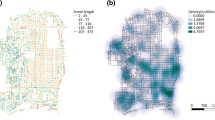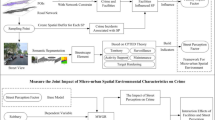Abstract
Understanding the influencing mechanism of the urban streetscape on crime is fairly important to crime prevention and urban management. Recently, the development of deep learning technology and big data of street view images, makes it possible to quantitatively explore the relationship between streetscape and crime. This study computed eight streetscape indexes of the street built environment using Google Street View images firstly. Then, the association between the eight indexes and recorded crime events was revealed with a poisson regression model and a geographically weighted poisson regression model. An experiment was conducted in downtown and uptown Manhattan, New York. Global regression results show that the influences of Motorization Index on crimes are significant and positive, while the effects of the Light View Index and Green View Index on crimes depend heavily on the socioeconomic factors. From a local perspective, the Pedestrian Space Index, Green View Index, Light View Index and Motorization Index have a significant spatial influence on crimes, while the same visual streetscape factors have different effects on different streets due to the combination differences of socioeconomic, cultural and streetscape elements. The key streetscape elements of a given street that affect a specific criminal activity can be identified according to the strength of the association. The results provide both theoretical and practical implications for crime theories and crime prevention efforts.
Similar content being viewed by others
References
Troy A, Nunery A, Grove J M. The relationship between residential yard management and neighborhood crime: an analysis from baltimore city and county. Landscape and Urban Planning, 2016, 147: 78–87
He L, Páez A, Liu D. Built environment and violent crime: an environmental audit approach using google street view. Computers, Environment and Urban Systems, 2017, 66: 83–95
Wang L, Lee G, Williams I. The spatial and social patterning of property and violent crime in toronto neighbourhoods: a spatial-quantitative approach. ISPRS International Journal of Geo-Information, 2019, 8(1): 51
Cozens P, Davies T. Crime and residential security shutters in an Australian suburb: exploring perceptions of ‘eyes on the street’, social interaction and personal safety. Crime Prevention and Community Safety, 2013, 15(3): 175–191
Reynald D M, Elffers H. The future of newman’s defensible space theory: linking defensible space and the routine activities of place. European Journal of Criminology, 2009, 6(1): 25–46
Wilson J Q, Kelling G L. Broken windows. Atlantic Monthly, 1982, 249(3): 29–38
Michael Cozens P, Saville G, Hillier D. Crime prevention through environmental design (CPTED): a review and modern bibliography. Property Management, 2005, 23(5): 328–356
Cozens P, Love T. A review and current status of crime prevention through environmental design (CPTED). Journal of Planning Literature, 2015, 30(4): 393–412
Chalfin A, Hansen B, Lerner J, Parker L. Reducing crime through environmental design: evidence from a randomized experiment of street lighting in new york city. National Bureau of Economic Research, 2019
Lee I, Jung S, Lee J, Macdonald E. Street crime prediction model based on the physical characteristics of a streetscape: analysis of streets in low-rise housing areas in South Korea. Environment and Planning B: Urban Analytics and City Science, 2019, 46(5): 862–879
Barnum J D, Caplan J M, Kennedy L W, Piza L E. The crime kaleidoscope: a cross-jurisdictional analysis of place features and crime in three urban environments. Applied Geography, 2017, 79: 203–211
Wolfe M K, Mennis J. Does vegetation encourage or suppress urban crime? evidence from Philadelphia, PA Landscape and Urban Planning, 2012, 108(2–4): 112–122
Zhou H, Liu L, Lan M, Yang B, Wang Z. Assessing the impact of nightlight gradients on street robbery and burglary in Cincinnati of Ohio state, USA. Remote Sensing, 2019, 11(17): 1958
Patino J E, Duque J C, Pardo-Pascual J E, Ruiz L A. Using remote sensing to assess the relationship between crime and the urban layout. Applied Geography, 2014, 55: 48–60
Rundle A G, Bader M D M, Richards C A, Neckerman K M, Teitler J O. Using google street view to audit neighborhood environments. American Journal of Preventive Medicine, 2011, 40(1): 94–100
Andersson V O, Birck M A F, Araujo R M. Investigating crime rate prediction using street-level images and siamese convolutional neural networks. In: Proceedings of Latin American Workshop on Computational Neuroscience. 2017, 81–93
Fu K, Chen Z, Lu C. Streetnet: preference learning with convolutional neural network on urban crime perception. In: Proceedings of the 26th ACM SIGSPATIAL International Conference on Advances in Geographic Information Systems. 2018, 269–278
Chen L C, Zhu Y, Papandreou G, Schroff F, Adam H. Encoder-decoder with atrous separable convolution for semantic image segmentation. In: Proceedings of the European Conference on Computer Vision. 2018, 801–818
Li X, Zhang C, Li W. Does the visibility of greenery increase perceived safety in urban areas? evidence from the place pulse 1.0 dataset. ISPRS International Journal of Geo-Information, 2015, 4(3): 1166–1183
Li X, Ratti C, Seiferling I. Quantifying the shade provision of street trees in urban landscape: a case study in Boston, USA, using google street view. Landscape and Urban Planning, 2018, 169: 81–91
Li X, Zhang C, Li W, Ricard R, Meng Q, Zhang W. Assessing street-level urban greenery using google street view and a modified green view index. Urban Forestry and Urban Greening, 2015, 14(3): 675–685
Dai Z, Hua C. The improvement of street space quality measurement method based on streetscape. Planners, 2019, 35(9): 57–63
Tang J, Long Y. Metropolitan street space quality evaluation: second and third ring of beijing, inner ring of shanghai. Planners, 2017, 33(2): 68–73
Yue H, Zhu X, Ye X, Hu T, Kudva S. Modelling the effects of street permeability on burglary in Wuhan, China. Applied Geography, 2018, 98: 177–183
Tobler W R. A computer movie simulating urban growth in the Detroit region. Economic Geography, 1970, 46(sup1): 234–240
Fuentes C M, Jurado V. Spatial pattern of motor vehicle thefts in Ciudad Juárez, Mexico: an analysis using geographically weighted poisson regression. Applied Geography, 2019, 5(1–2): 176–191
Bidanset P E, Lombard J R. Evaluating spatial model accuracy in mass real estate appraisal: a comparison of geographically weighted regression and the spatial lag model. Cityscape, 2014, 16(3): 169–182
Getis A. A history of the concept of spatial autocorrelation: a geographer’s perspective. Geographical Analysis, 2008, 40(3): 297–309
Cotte Poveda A. Violence and economic development in Colombian cities: a dynamic panel data analysis. Journal of International Development, 2012, 24(7): 809–827
Ekkel E D, de Vries S. Nearby green space and human health: evaluating accessibility metrics. Landscape and Urban Planning, 2017, 157: 214–220
Cabrera-Barona P F, Jimenez G, Melo P. Types of crime, poverty, population density and presence of police in the metropolitan district of Quito. ISPRS International Journal of Geo-Information, 2019, 8(12): 558
Fuentes C M, Hernandez V. Housing finance reform in Mexico: the impact of housing vacancy on property crime. International Journal of Housing Policy, 2014, 14(4): 368–388
Xu C, Liu L, Zhou S, Jiang C. Spatial heterogeneity of micro-spatial factors’ effects on street robberies: a case study of DP peninsula. Geographical Research, 2017, 36(12): 2492–2504
Wang H, Kifer D, Graif C, Li Z. Crime rate inference with big data. In: Proceedings of the 22nd ACM SIGKDD International Conference on Knowledge Discovery and Data Mining. 2016, 635–644
Kadar C, Pletikosa I. Mining large-scale human mobility data for long-term crime prediction. EPJ Data Science, 2018, 7(1): 26
Setiawan I, Dede M, Sugandi D, Widiawaty M A. Investigating urban crime pattern and accessibility using geographic information system in Bandung City. KnE Social Sciences, 2019, 3(21): 535–548
Steinbach R, Perkins C, Tompson L, Johnson S, Armstrong B, Green J, Grundy C, Wilkinson P, Edwards P. The effect of reduced street lighting on road casualties and crime in England and Wales: controlled interrupted time series analysis. Journal of Epidemiol and Community Health, 2015, 69(11): 1118–1124
Ye C, Chen Y, Li J. Investigating the influences of tree coverage and road density on property crime. ISPRS International Journal of Geo-Information, 2018, 7(3): 101
Davies T, Johnson S D. Examining the relationship between road structure and burglary risk via quantitative network analysis. Journal of Quantitative Criminology, 2015, 31(3): 481–507
Wang J, Wu N, Lu X, Zhao X, Feng K. Deep trajectory recovery with fine-grained calibration using kalman filter. IEEE Transactions on Knowledge and Data Engineering, 2021, 33(3): 921–934
Chen C, Jiao S, Zhang S, Liu W, Feng L, Wang Y. TripImputor: realtime imputing taxi trip purpose leveraging multi-sourced urban data. IEEE Transactions on Intelligent Transportation Systems, 2018, 19(10): 3292–3304
Chen C, Ding Y, Xie X, Zhang S, Wang Z, Feng L. TrajCompressor: an online map-matching-based trajectory compression framework leveraging vehicle heading direction and change. IEEE Transactions on Intelligent Transportation Systems, 2019, 21(5): 2012–2028
Chen C, Zhang D, Guo B, Ma X, Pan G, Wu Z. TripPlanner: personalized trip planning leveraging heterogeneous crowdsourced digital footprints. IEEE Transactions on Intelligent Transportation Systems, 2014, 16(3): 1259–1273
Chen C, Zhang D, Ma X, Guo B, Wang L, Wang Y, Sha E. Crowddeliver: planning city-wide package delivery paths leveraging the crowd of taxis. IEEE Transactions on Intelligent Transportation Systems, 2016, 18(6): 1478–1496
Wang J, Wu J, Wang Z, Gao F, Xiong Z. Understanding urban dynamics via context-aware tensor factorization with neighboring regularization. IEEE Transactions on Knowledge and Data Engineering, 2019, 32(11): 2269–2283
Wang J, Wang Y, Zhang D, Lv Q, Chen C. Crowd-powered sensing and actuation in smart cities: current issues and future directions. IEEE Wireless Communications, 2019, 26(2): 86–92
Gao J, He Y, Wang Y, Wang X, Wang J, Peng G, Chu X. STAR: spatio-temporal taxonomy-aware tag recommendation for citizen complaints. In: Proceedings of the 28th ACM International Conference on Information and Knowledge Management. 2019, 1903–1912
Gong F, Zeng Z, Zhang F, Li X, Ng E, Norford L K. Mapping sky, tree, and building view factors of street canyons in a high-density urban environment. Building and Environment, 2018, 134: 155–167
Kang H W, Kang H B. Prediction of crime occurrence from multimodal data using deep learning. PLoS ONE, 2017, 12(4): e0176244
Acknowledgements
The work was supported by the National Natural Science Foundation of China (Grant No. 61872050, No. 62172066), the Chongqing Basic and Frontier Research Program (cstc2018jcyjAX0551), the Fundamental Research Funds for the Central Universities (2018CDJSK03XK01), and the Chongqing Technology Innovation and Application Development Key Project (ctsc2019jscx-gksbX0066).
Author information
Authors and Affiliations
Corresponding authors
Additional information
Mingyu Deng is currently a master student at College of Computer Science, Chongqing University, China. She obtained her bachelor degree of Computer Science and Technology of Chongqing University of Posts and Telecommunications, China in 2018. Her research interests include smart cities and data visualization.
Wei Yang received the PhD degree in School of Resource and Environmental Science at Wuhan University, China in 2019. He is currently a Lecturer at Chongqing University, China. His research interests include trajectory data mining, human behavior analysis, GIS and smart city.
Chao Chen is a full professor at College of Computer Science, Chongqing University, China. He obtained his PhD degree from Pierre and Marie Curie University and Institut Mines-Télécom/ Télécom SudParis, France in 2014. He received the BSc and MSc degrees in control science and control engineering from Northwestern Polytechnical University, China in 2007 and 2010, respectively. Dr. Chen got published over 80 papers including 20 ACM/IEEE Transactions. His work on taxi trajectory data mining was featured by IEEE Spectrum in 2011 and 2016, respectively. He was also the recipient of the Best Paper Runner-Up Award at MobiQuitous 2011.
In 2009, he worked as a Research Assistant with Hong Kong Polytechnic University, China. His research interests include pervasive computing, mobile computing, urban logistics, data mining from large-scale GPS trajectory data, and big data analytics for smart cities.
Chenxi Liu is currently a master degree candidate at College of Computer Science, Chongqing University, China. He received his bachelor degree from the School of Optical and Electronic Information of Huazhong University of Science and Technology, China in 2017. His research interests include reinforcement learning and ride-sharing platform optimization.
Electronic supplementary material
Rights and permissions
About this article
Cite this article
Deng, M., Yang, W., Chen, C. et al. Exploring associations between streetscape factors and crime behaviors using Google Street View images. Front. Comput. Sci. 16, 164316 (2022). https://doi.org/10.1007/s11704-020-0007-z
Received:
Accepted:
Published:
DOI: https://doi.org/10.1007/s11704-020-0007-z




